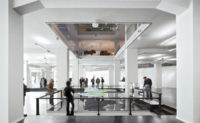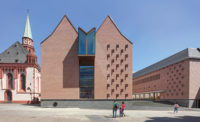Berlin
Wrapped in facades of concrete, etched with the fragments of enlarged sketches, the Tchoban Foundation Museum for Architectural Drawing in Berlin exploits the craft of construction to celebrate the art of drawing. The building is articulated as four slightly offset levels, like a stack of plan files pulled slightly askew—another nod to its holdings. Referring to the contents was the scheme of the man animating the entire project. Architect Sergei Tchoban, an accomplished draftsman and collector of historical architectural drawings, who practices in Germany and Moscow, established a foundation in 2009 to display his collection and to encourage young architects to draw. Subsequently, the foundation's board of trustees decided to build a museum with an archive, study facilities, and exhibition space. Tchoban's Moscow office (SPEECH Tchoban & Kuznetsov) developed the design, and his Berlin branch (NPS Tchoban Voss) oversaw the detailing and site supervision.
Located on the site of the Pfefferberg, a former brewery whose landmarked brick buildings now house artist studios and cultural institutions, the museum occupies a 26-by-39-foot plot and adjoins the firewall of an existing historic structure. Small and arresting, it gently mediates between the industrial context and the surrounding 19th-century residential buildings. Its facade rises to 72 feet, the typical height of eaves on inner-city Berlin buildings, and the concrete's parchment tone harmonizes with the pastel exteriors of the surrounding apartment blocks. Even the dramatic glass box that cantilevers out above the concrete facade can be considered a bold interpretation of the setback level completing the typical Berlin block. The scored concrete also acknowledges, but does not imitate, the brewery's brick architecture, as both display muscular forms that lay bare their materiality.
Unlike the adjacent Pfefferberg complex, where century-old structures incubate cutting-edge art and design, the museum mobilizes contemporary architecture to preserve older works. Upon occasion, Tchoban has placed words or images on the facade of a project to highlight meanings associated with a site. In a similar manner, the drawings etched into the museum's skin communicate the building's function as a repository for historical architectural representation. They even show some of the museum's holdings and acknowledge the genesis of the collection. Two fragments taken from Tchoban's first acquisition, a sketch by Pietro di Gottardo Gonzaga (1751–1831), an Italian artist active in Russia, appear on the face of the third and fourth levels; an excerpt from a drawing by Angelo Toselli (1765–1827), also Italian and active in Russia, repeats along the second level; and, on the first level, a section of another Gonzaga sketch is visible.
More than mere signifiers, the concrete facades are the supporting structure. The building is constructed as a massive reinforced-concrete shell, like a hollow tower. Upon completion, the floor levels were inserted into this form. The bays jutting out from the second and third levels, respectively, provide bracing. On the concrete's inner side, a layer of cellular glass insulation acts as a vapor barrier. Behind that, a limestone-masonry wall, coated with lime-cement plaster, regulates the interior moisture content and air quality. As a result, the building requires a relatively small HVAC system.
Inside, all the components of a museum are present, albeit in an abbreviated form. A niche on the northwestern elevation opens into the combined reception area and library. This room leads to the stairway and elevator, which connects to the galleries (second and third levels), the archive (fourth level), and the administrative office (fifth level/roof). Technical and service areas occupy the basement. Bays articulate each gallery, and every floor has at least one unique feature, such as a small room accessed from the third level gallery that overlooks a nearby park, or the exquisite hand-carved lines, recalling the facade, etched into the walnut paneling of the reception/library area. On the roof, panoramic views top this incredibly compact, spatially rich building.
European critics have praised the museum's design and applauded Tchoban's role as a patron. One can quibble with little details: the irregularly shaped windows cut into the base of the facade and along the eastern side of the stairway seem arbitrary and do not provide much illumination. Yet the intensity and quality of the Tchoban Foundation Museum for Architectural Drawing is just right for its content: an encounter with it provides the perfect inspiration to reach for a pencil and start drawing.
The fabrication process was painstaking. The crew used a CNC milling machine to etch the motifs into a fiberboard panel, chamfering the line edges to create the impression that the lines were sculpted into the concrete. Then they poured a rubberlike liquid polyurethane elastomer onto the fiberboard, which formed a mold upon hardening. They affixed this mold to particleboard, then secured the package to the interior of the concrete formwork, situating the ties to avoid interfering with the lines of the drawings, and sealing the corners and joints with silicon.Constructed from poured-in-place reinforced concrete, the waterproof facade of the Tchoban Foundation Museum for Architectural Drawing features fragments from the collection etched into the surface. To do this, architect Sergei Tchoban and his team scanned works from his archives. They isolated a section of each drawing, then copied and arranged the resulting motifs in patterns. Each of the building’s various facades displays one motif repeated, like a horizontal band of irregularly overlapping shingles.
The concrete was then mixed with pigments to produce the parchment tone. To ensure a uniform appearance, each level was poured continuously during optimal weather conditions. Once dry, the formwork was stripped. The mold affixed to the particleboard was removed, and matching fiber cement stoppers were plugged into the tie holes. Finally, the concrete received a nano coating to repel dirt and graffiti.
PeopleOwner: Tchoban Foundation. Museum for Architectural Drawing, Christinenstraße 18a, 10119 Berlin, Germany
Architect:
Personnel in architect's firm who should receive special credit: Associate architect(s):Ulrike Graefenhain (reg. Architect), Philipp Bauer (reg. Architect) Interior designer: Ulrike Graefenhain (reg. Architect)
Engineer(s): Structural engineering: PPW Dipl.-Ing. D. Paulisch, Berlin, +49 30 3929121, paulisch-ppw@t-online.de Landscape: atelier 8 landschaftsarchitekten, Berlin, +49 30 22620490, info@atelier8.eu Lighting: Kardorff Ingenieure (also façade lighting), Berlin, +49 30 36999040, berlin@kardorff.de
Other:
Photographer(s): Renderer(s): rendering © nps tchoban voss CAD system, project management, or other software used: AutoCAD Architecture 2012, Autodesk 3ds Max 2012 Size: 5,360 square feet Cost: withheld Completion date: May 2013 |
Products
Structural system
Sheathing matrices: RECKLI GmbH, Herne, Tel +49 2323 17060, info@reckli.de
Exterior cladding Moisture barrier: Attention: Since the reinforced concrete walls were cast on site jointlessly, constituting the load-bearing structure of the building, no other barrier was necessary for the façade and the outer walls;
Roofing
Windows Metal frame:MBM Konstruktionen GmbH, Möckmühl, +49 6298 38254, h.mogck@mbm-konstruktionen.de
Glazing Skylights: Lamilux CI-System Glaselement F, Lamilux Heinrich Strunz Holding GmbH & Co. KG, Rehau, +49 (0) 9283 / 595 0, information@lamilux.de Insulated-panel or plastic glazing: (please see windows)
Doors Metal/glass doors: inner entrance to reception: MBM Konstruktionen GmbH, Möckmühl, +49 6298 38254, h.mogck@mbm-konstruktionen.de Wooden doors to the staircase: Lindner AG, Arnstorf, +49 8723 200, info@lindner-group.com Special doors: rescue openings first and third floor, inner wing: cold storage doors modified by MBM Konstruktionen GmbH; outer wing: Wilking Metallbau GmbH, Berlin, +49 30 53639130, wilking-metallbau@gmx.de; concrete filling: BSS Beton – System-Schalungsbau GmbH, Berlin, +49 30 8209080, info@bss.ag
Hardware Closers: invisibly integrated: Dorma IST 96 Exit devices: no specification Security devices: Locking system: IKON VersoCliq®, Assa Abloy, Sicherheitstechnik GmbH, Berlin, +49 30 81060, info@assaabloy.de
Interior finishes: Lindner AG, Arnstorf, +49 8723 200, info@lindner-group.com Cabinetwork and custom woodwork: Tischlerei Hollenbach, Berlin, +49 30 4496989, s.hollenbach@tischlerei-hollenbach.de Paints and stains:no specification Paneling: Tischlerei Hollenbach, Berlin, +49 30 4496989, s.hollenbach@tischlerei-hollenbach.de
Floor and wall tile: storage: Marazzi, Modena, Italy, +39 059 384111, info@marazzi.it Raised flooring: FLOOR and more® Comfort, Lindner AG, Arnstorf, +49 8723 200, info@lindner-group.com
Furnishings Reception furniture: desk: Tischlerei Hollenbach, Berlin, +49 30 4496989, s.hollenbach@tischlerei-hollenbach.de Chairs: Baxter, Como, Italy, +39 031 35999, info@baxter.it Tables: Tischlerei Hollenbach, Berlin, +49 30 4496989, s.hollenbach@tischlerei-hollenbach.de Other furniture (use additional sheet if necessary): custom design concrete stools/tables: Betonmoebel GmbH Dipl.-Ing. Karl- Heinz Suppa, Berlin, +49 30 22487190 betonmoebel@hotmail.com
Lighting
Interior ambient lighting: exhibition space: Selux, Berlin, +49 (30) 720010, info@selux.de Dimming System or other lighting controls: Klaus Löhr GmbH und Co. KG, info@loehr-kg.de, +40 30 252 99 400
Conveyance Plumbing: Schwiete Anlagen Versorgungstechnik GmbH, Berlin, +49 30 3030020, post@schwiete.net
faucets: Hansgrohe Axor, Schiltach, +49 7836 510, info@hansgrohe.de
HVAC: Air conditioning ventilation unit: Menerga GmbH, Mülheim an der Ruhr, +49 208 99810, info@menerga.com
Energy
Add any additional building components or special equipment that made a significant contribution to this project: |


























